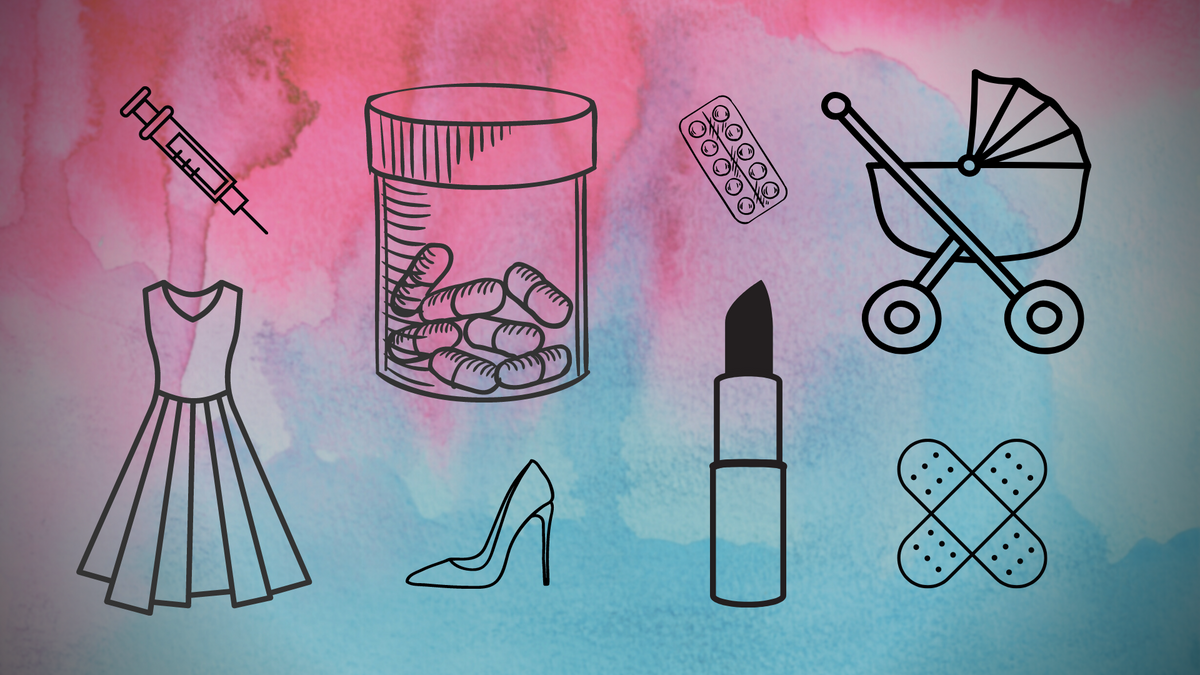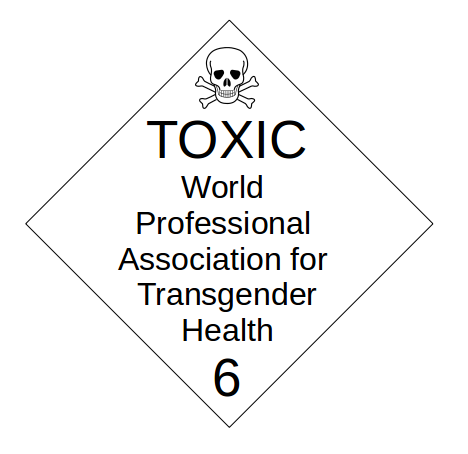Four Reasons To Stop Saying “Gender Dysphoria”
The vague and sexist concept creates the very symptoms it claims to describe

The gender identity debate is inherently a debate of language and concepts. Concepts like “transgender” and “transsexual” are hotly debated among radical feminists.
Many advocate against the use of these concepts as upholding the false premise behind them — that a person can change their sex.
In the search for accurate terms to question the practices and ideas of transgenderism, gender critical and radical feminists may fall back on another term: “gender dysphoria.”
Recently, I saw one woman announce on social media: “I just had a wonderful idea. From now on, I try to use the abbreviation PGD - people with gender dysphoria - instead of ‘trans people.’”
As a trained and practicing clinical psychologist, but above all a radical feminist, I reject the concept of gender dysphoria.
Rather than relying on it, I suggest we start debating the underlying assumptions of the clinical term “gender dysphoria” and stop using it in favor of clearer language describing and criticizing the practices and ideology of transgenderism. Here is why.
1. The concept of “Gender Dysphoria” is sexist
The 5th Diagnostic and Statistical Manual of Mental Disorders (DSM-5) diagnosis of “gender dysphoria” uses “gender” when it means “sex” or “sex role.” It is unclear whether the authors see a difference between these two.
By using “gender” at times for “sex” and at other times for “sex roles,” they ignore the feminist definition of sex roles as patriarchal tools of control over women. By using “gender,” when they mean “sex,” they reveal that they do not believe in the material reality of sexed bodies, but are members of the cult of “gender identity.”
The DSM-5 defines “gender dysphoria” in adolescents and adults as “incongruence between one’s experienced/expressed gender and their assigned gender lasting at least 6 months.” This state should be manifested by at least two of the following (my own translation is added in brackets):
- A marked incongruence between one’s experienced/expressed gender [sex role stereotype] and primary and/or secondary sex characteristics
- A strong desire to be rid of one’s primary and/or secondary sex characteristics because of a marked incongruence with one’s experienced/expressed gender [sex role stereotype]
- A strong desire for the primary and/or secondary sex characteristics of the other gender [sex]
- A strong desire to be of the other gender [sex] or some alternative gender different from one’s assigned gender [?]
- A strong desire to be treated as the other gender [sex] or as some alternative gender or some alternative gender different from one’s assigned gender [?]
- A strong conviction that one has the typical feelings and reactions of the other gender [sex] or some alternative gender different from one’s assigned gender [?]
The definition for “gender dysphoria” in children sounds very similar, but adds “preference for cross-dressing,” toys, games, and activities that are culturally associated with the other sex. For all age categories, the DSM-5 stresses that “in order to meet criteria for the diagnosis of gender dysphoria, the condition must also be associated with clinically significant distress or impairment in social, occupational, or other important areas of functioning.”
“Gender dysphoria” is no less a social construction than “gender” is. The concept of “gender dysphoria” on the one hand focuses on distress and on the other on a story that is supposed to explain this distress—the mismatch between sex and sex role stereotypes.
Using the term “incongruence” within these criteria suggests that everyone fulfills or should fulfill a sex role. It does not reject sex roles or sex role stereotypes themselves. It affirms them and just problematizes a probable distress with them. It also is based on ideas how congruence between sex and sex roles would look like which affirms the idea of traditional sex roles.
2. The concept of “Gender Dysphoria” is vague
Talking about “someone with gender dysphoria” could mean multiple different things. For example:
- She doesn’t conform to traditional sex role stereotypes and realizes that others accept her more if she pretends to be a boy
- She gets the constant message that homosexuality is a horrible thing and she gets rewarded when presenting as the other sex instead
- She has the urge to mutilate her body or feels a deep disgust towards her physique
- He has developed an autogynephilic fetish from the consumption of pornography
The term “gender dysphoria” is an umbrella term in the same way as the term “transgender.” It is basically useless when we strive to educate others on transgenderism.
There are many other ways to refer to someone’s mental distress in relation to sex or sex role stereotypes. For example, this person experiences sadness, despair, suicidal thoughts, the belief that she must fulfill a specific sex role, the distress over not fulfilling a socially expected sex role, insecurity, fear, body dysphoria, rejection of one’s sexed body or, in the words of Jennifer Bilek, dissociation from one’s body, being glorified and promoted by a huge industry.
There is no need for using a psychiatric term that conveys only sexist notions and reveals no specific information about what one is referring to. When others refer to “gender dysphoria”, we need to ask them: What do you mean by that? Seeking clarification helps the speaker and audience more clearly understand the socially constructive nature of transgenderism and enables a critical view of it, including in conversations with people who use the label for themselves.
The feminist activists Elie and Nele from the campaign Post Trans report that many affected women find relief in naming each feeling “for what it is,” instead of referring to the term “gender dysphoria.”
They explain that women can specify their experiences, for instance by saying they feel “discomfort from being seen as a woman” or “feeling uncomfortable with my breasts.” Breaking down psychiatric terms to specific experiences and perceptions is a great way to de-pathologize women, to stress our common experiences and to connect with each other.
3. It supports the ideas and practices of transgenderism
Use of the term “gender dysphoria” is accompanied by the assumption that the perception or experience at hand needs some form of clinical intervention. It is, after all, a clinical diagnosis.
The so-called “treatment” recommended by the clinical community in 2022 consists of hormone blockers, affirmation of cross-sex fantasies and invasive surgery. But even if psychotherapy is recommended instead of medical interventions, this still operates within a psychiatric misogynistic framework.
There may be other ways to deal with the distress that comes from being at odds with sex role stereotypes. Despite personal anecdotes of overcoming this distress through learning about radical feminism, this is not pursued even by gender critical psychotherapists as a potential remedy or a way to channel this distress. None recommend feminist activism, or participation in radical lesbian communities.
Usually, the psychiatric and psychotherapeutic communities do not recognize psychotherapy’s unwanted side effects, as for instance its negative impact on the liberation and feminist awareness of women, as Celia Kitzinger and Rachel Perkins have warned us long ago.
Instead, those who refer to the psychiatric concept of “gender dysphoria” when discussing the problems of transgenderism demonstrate uncritical views of the whole system of psychotherapy and psychiatry itself, which includes the institution of psychiatric diagnoses.
As feminists, we have to criticize these systems and the concepts they use, work that feminists like Phyllis Chesler and Celia Kitzinger already started many years ago. This is especially true on issues related to sex and sex role stereotypes, which Sheila Jeffreys has spent decades documenting.
Upholding the label of “gender dysphoria” confirms the psychiatric notion that the body is the actual problem and used in feminist circles it suggests that mitigating suffering on an individual level should be feminists’ main focus of concern.
In addition, it seems that the diagnosis itself creates the symptoms that it tries to describe. Some women reported that the aversion against their body started only after others assigned the label “gender dysphoria” to them, which is an example of the strong constitutive nature of concepts and ideas. As Emily Köhler testified in her talk at Women’s Declaration International, relating to the concept of “gender dysphoria” taught her to dissociate from her body.
The diagnosis and concept of “gender dysphoria” itself is 100 % intertwined with today’s gender identity ideology. It is inconsistent to condemn the latter and preserve the former as right and valid. The label is so strongly connected to the gender industry, that we put a woman in danger of undergoing harmful chemical and surgical interventions, once we use or repeat the term “gender dysphoria” in reference to her.
4. The label of “Gender Dysphoria” others women
When feminists use the concept of “gender dysphoria” to explain other women’s distress, they define them as having a psychiatric illness; this is not only pathologizing, but also othering, in declaring someone is fundamentally different from us - something is wrong with that woman and must be either fixed or tolerated.
As feminists, we know that it’s perfectly healthy, and indeed useful, to feel uncomfortable with sex roles and sex role stereotypes. We know that it is normal - albeit not desirable - to not feel at ease with one’s female body under male supremacy. Furthermore, in referring to these women as “people with gender dysphoria” we reduce them to these experiences and contribute to them identifying with an apolitical sexist psychiatric narrative.
Instead of othering women, we could point out the commonalities in our experiences. When we de-pathologize women who claim to have “gender dysphoria,” we help them to understand that their experiences make perfect sense in a misogynistic world and that there are always alternatives to self-harm. The advice given by Elie and Nele here goes in this direction again. They recommend women to search for role models with similar bodies and observable nonconformity to sex role stereotypes, in addition to developing a feminist awareness and to questioning internalized sex role stereotypes.
Use clear language to address the practices of transgenderism
If feminists want to attack the ideas and practices of transgenderism, it’s time to refrain from using the misogynist psychiatric concept of “gender dysphoria” and start criticizing it instead.
Instead of relying on diagnostic labels, specifically describe the behavior and experiences of the women and men involved.
The next generation of radical feminists must not forget the work of our foremothers to describe psychiatry’s part in the promotion of sex role stereotypes and of misogyny. We need to revive the feminist tradition of exposing the misogyny and politics of psychiatry’s and the medical profession’s notions, thinking and language. The language, concepts and explanations of psychiatrists and psychotherapists are not the solution in the trans debate. They are part of the problem.
The generous support of our readers allows 4W to pay our all-female staff and over 50 writers across the globe for original articles and reporting you can’t find anywhere else. Like our work? Become a monthly donor!
Enter your email below to sign in or become a 4W member and join the conversation.
(Already did this? Try refreshing the page!)




Comments